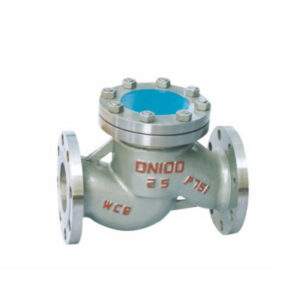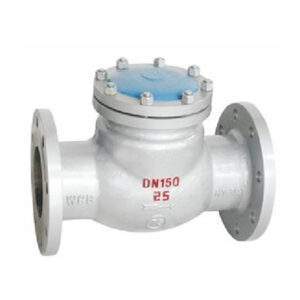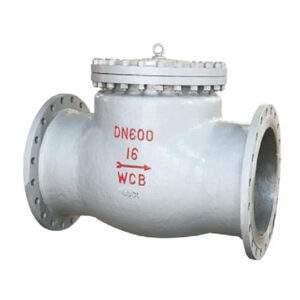Introduction

Water check valves are essential components in various fluid systems, preventing backflow and ensuring unidirectional flow. This comprehensive guide delves into the intricacies of water check valves, covering their types, applications, selection criteria, installation, maintenance, and troubleshooting. Whether you’re a seasoned engineer or a homeowner looking to understand your plumbing system better, this guide will provide valuable insights into the world of water check valves.
Understanding Water Check Valve Functionality
A water check valve, also known as a non-return valve or one-way valve, is a mechanical device that allows fluid to flow in only one direction. This unidirectional flow is crucial in preventing backflow, which can lead to contamination, damage to equipment, and inefficiencies in the system. The working principle of a water check valve is relatively simple. It utilizes a moving part, such as a disc, ball, or swing, that opens when fluid flows in the desired direction and closes when the flow attempts to reverse.
How Water Check Valves Prevent Backflow
The primary function of a water check valve is to prevent backflow. This is achieved through the design and operation of the internal moving part. When fluid flows in the forward direction, the pressure of the fluid overcomes the opposing force (gravity, spring, or back pressure) and opens the valve. When the flow stops or attempts to reverse, the opposing force closes the valve, preventing backflow. This simple yet effective mechanism ensures the integrity and efficiency of various fluid systems.
Types of Water Check Valves

Several types of water check valves are available, each designed for specific applications and operating conditions. Understanding these different types is crucial for selecting the right valve for your needs.
Swing Check Valves
Swing check valves are one of the most common types. They feature a hinged disc that swings open to allow forward flow and closes against a seat to prevent backflow. Swing check valves are suitable for various applications, including water supply systems, wastewater treatment, and HVAC systems.
Lift Check Valves
Lift check valves operate by lifting a disc off its seat to allow forward flow. When the flow stops or reverses, the disc falls back onto the seat, preventing backflow. Lift check valves are commonly used in high-pressure applications and are available in various designs, including piston and ball types.
Ball Check Valves
Ball check valves utilize a ball as the closing element. The ball rests on a seat and is lifted off the seat by forward flow. When the flow stops or reverses, the ball returns to the seat, preventing backflow. Ball check valves are simple in design and reliable in operation, making them suitable for various applications, including pumps, chemical processing, and irrigation systems.
Spring Check Valves
Spring check valves use a spring to assist in closing the valve. The spring provides a positive closing force, ensuring quick and reliable shutoff. Spring check valves are suitable for applications where rapid closure is required, such as pulsating flow systems.
Duckbill Check Valves
Duckbill check valves feature a flexible elastomeric sleeve shaped like a duck’s bill. Forward flow opens the “bill,” allowing fluid to pass through. Back pressure closes the bill, preventing backflow. Duckbill check valves are commonly used in wastewater and sewage applications due to their ability to handle solids and slurries.
Selecting the Right Water Check Valve
Choosing the correct water check valve is crucial for optimal system performance and reliability. Several factors should be considered during the selection process.
Application Requirements
The specific application will dictate the type of check valve required. Factors such as fluid type, flow rate, pressure, temperature, and operating environment should be considered.
Valve Size and Connection Type
The valve size should be matched to the pipe size to ensure proper flow and prevent pressure drop. The connection type (threaded, flanged, or welded) should be compatible with the existing piping system.
Material Compatibility
The valve material should be compatible with the fluid being handled to prevent corrosion and degradation. Common materials include brass, bronze, stainless steel, and PVC.
Pressure and Temperature Ratings
The valve should be rated for the operating pressure and temperature of the system. Exceeding these ratings can lead to valve failure and system damage.
Water Check Valve Installation and Maintenance
Proper installation and regular maintenance are crucial for ensuring the long-term performance and reliability of check valves.
Installation Guidelines
Follow the manufacturer’s instructions for proper installation. Ensure the valve is installed in the correct orientation to allow for proper flow direction.
Regular Inspection and Cleaning
Regularly inspect the valve for signs of wear, damage, or debris buildup. Clean the valve as needed to ensure proper operation.
Troubleshooting Common Issues
Common issues with water check valves include leaks, noise, and failure to open or close. Troubleshooting these issues involves inspecting the valve for damage, debris, or improper installation.
Applications of Water Check Valves
Water check valves find applications in a wide range of industries and systems.
Plumbing Systems
In residential and commercial plumbing, check valves prevent backflow of wastewater into potable water lines.
Irrigation Systems
In irrigation, check valves prevent backflow of fertilizer or pesticides into the water source.
Industrial Processes
In various industrial processes, check valves maintain unidirectional flow and prevent contamination or damage to equipment.
Pump Systems
Check valves are often used in conjunction with pumps to prevent backflow when the pump is not operating.
Water Check Valve Selection Table

The following table provides a general guideline for selecting a water check valve based on different application scenarios.
| Application Scenario | Recommended Check Valve Type | Key Considerations |
|---|---|---|
| Residential Plumbing (Potable Water) | Spring Check Valve, Swing Check Valve | Low pressure, clean water |
| Wastewater Systems | Duckbill Check Valve, Swing Check Valve | Solids, slurries, potential for debris |
| Irrigation Systems | Ball Check Valve, Swing Check Valve | Low pressure, potential for debris |
| High-Pressure Industrial Applications | Lift Check Valve | High pressure, precise operation |
| Chemical Processing | Specific Material Check Valves (e.g., Stainless Steel, PVC) | Chemical compatibility, temperature |
Conclusion
Water check valves are critical components in various fluid systems, ensuring efficient and safe operation. By understanding the different types, applications, selection criteria, installation, and maintenance of water check valves, you can ensure the optimal performance and longevity of your fluid systems. This comprehensive guide has provided a detailed overview of water check valves, equipping you with the knowledge to make informed decisions and maintain your systems effectively. This information should help you understand the importance of check valves and ensure you choose the right one for your needs. Remember to always consult with a qualified professional for specific applications or complex systems. This detailed guide should be a valuable resource for anyone seeking information on water check valves.
FAQ
What is the purpose of a water check valve?
A water check valve prevents backflow and ensures unidirectional flow in a fluid system.
How does a water check valve work?
A water check valve utilizes a moving part that opens to allow forward flow and closes to prevent backflow.
What are the different types of water check valves?
Common types include swing check valves, lift check valves, ball check valves, spring check valves, and duckbill check valves.
How do I choose the right water check valve?
Consider factors such as application requirements, valve size, material compatibility, and pressure and temperature ratings.
